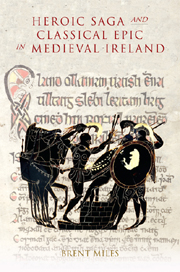Book contents
- Frontmatter
- Contents
- Acknowledgements
- Note on Texts and Editions
- Abbreviations
- Introduction: Figmenta Poetica and Heroic Saga
- 1 Classical Learning in Medieval Ireland: The State of the Question
- 2 The Irish Classical Tales: Texts and Sources
- 3 Classicism and Togail Troí
- 4 Táin Bó Cúailnge and Latin Epic
- 5 The Rhetorical Set Piece and the Breslech of the Plain of Murthemne
- Afterword: An Invitation to Study
- Bibliography
- Index
- STUDIES IN CELTIC HISTORY
4 - Táin Bó Cúailnge and Latin Epic
Published online by Cambridge University Press: 12 September 2012
- Frontmatter
- Contents
- Acknowledgements
- Note on Texts and Editions
- Abbreviations
- Introduction: Figmenta Poetica and Heroic Saga
- 1 Classical Learning in Medieval Ireland: The State of the Question
- 2 The Irish Classical Tales: Texts and Sources
- 3 Classicism and Togail Troí
- 4 Táin Bó Cúailnge and Latin Epic
- 5 The Rhetorical Set Piece and the Breslech of the Plain of Murthemne
- Afterword: An Invitation to Study
- Bibliography
- Index
- STUDIES IN CELTIC HISTORY
Summary
Epic, ‘External Elements’ and Literary Imitatio
Táin Bó Cúailnge, ‘The Cattle-raid of Cúailnge’, describes how the men of the combined provinces of Connacht, Leinster and Munster, together termed ‘the men of Ireland’, conduct a táin bó, ‘cattle-raid’, into the province of Ulster. Commanded by Medb, queen of Connacht, the men of Ireland aim to take from Ulster the Donn Cúailnge, ‘Brown Bull of Cùailnge’. The Ulaid ‘men of Ulster’ are stricken with an annual debility which leaves them unable to repell their attackers. The defence of the province falls to a single fighter, Cù Chulainn. Cú Chulainn keeps the attackers at bay during the months of the Irish winter, from November through January, at which point the warriors of Ulster recover, rally to arms and overcome the men of Ireland in battle. The Donn Cùailnge, meanwhile, has engaged in battle with Findbennach, ‘the White-Horned Bull’ of Connacht, dismembers its opponent, and then itself succumbs to its injuries at the tale's conclusion.
This strange story, a sober depiction of early Irish seasonal warfare infused with fantastic mythological elements, was arguably the central text in the canon of heroic literature from medieval ireland. It certainly seemed to be so in the minds of those people who wrote that literature. In view of the number of surviving manuscript copies, distributed over at least three separate recensions, the Táin was more popular than any other text from the Ulster Cycle of heroic tales.
- Type
- Chapter
- Information
- Heroic Saga and Classical Epic in Medieval Ireland , pp. 145 - 193Publisher: Boydell & BrewerPrint publication year: 2011



